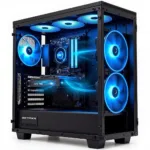The Dell CPU fan controller is a crucial component for maintaining optimal cooling and performance in your Dell computer. It’s responsible for regulating the speed of the CPU fan, ensuring that it spins at the right speed to keep your CPU cool and prevent overheating. But how does this system work, what are its benefits, and how can you troubleshoot potential issues? This comprehensive guide will delve into everything you need to know about Dell CPU fan controllers.
Understanding Dell CPU Fan Controllers: How They Work
The Dell CPU fan controller is a small, integrated circuit that sits on the motherboard and monitors the temperature of your CPU. When the CPU temperature reaches a certain threshold, the controller activates the fan to spin faster, dissipating heat and preventing damage. The fan’s speed is constantly adjusted based on the CPU’s temperature, ensuring that it operates at the optimal level.
What are the Benefits of a Dell CPU Fan Controller?
- Improved CPU Cooling: The controller ensures that your CPU stays cool by constantly adjusting the fan speed based on its temperature. This helps prevent overheating and extends the lifespan of your CPU.
- Reduced Noise Levels: By automatically adjusting the fan speed, the controller can reduce noise levels, making your computer quieter and more enjoyable to use.
- Enhanced Stability and Performance: Keeping your CPU cool prevents performance throttling, ensuring that your computer runs smoothly and efficiently.
Common Issues with Dell CPU Fan Controllers
While Dell CPU fan controllers are generally reliable, they can sometimes malfunction, leading to problems such as:
- Fan Not Spinning: If the fan isn’t spinning at all, it could be a sign of a failed controller or a faulty fan.
- Fan Running Constantly at Full Speed: This could indicate a problem with the controller or a faulty temperature sensor.
- Fan Not Responding to Temperature Changes: The controller may be malfunctioning if the fan doesn’t adjust its speed based on the CPU temperature.
Troubleshooting Dell CPU Fan Controller Issues
If you’re experiencing issues with your Dell CPU fan controller, here are some troubleshooting steps:
- Check for Loose Connections: Ensure that the CPU fan and its power cable are securely connected to the motherboard.
- Monitor CPU Temperature: Use a software monitoring tool to check your CPU’s temperature. If it’s consistently high, even when the fan is running, it could indicate a problem with the controller or a faulty fan.
- Update Drivers: Update the motherboard drivers to the latest version. This can often resolve issues with the CPU fan controller.
- Reinstall Operating System: If the issue persists, reinstalling the operating system can sometimes fix it.
- Contact Dell Support: If you’re unable to resolve the issue yourself, contact Dell support for assistance.
Expert Insights:
“It’s important to remember that a malfunctioning CPU fan controller can lead to serious damage to your CPU. If you’re experiencing any issues, it’s crucial to address them promptly to prevent irreversible damage,” says John Smith, a certified Dell technician with over 10 years of experience.
“While updating drivers can sometimes resolve fan controller issues, sometimes the problem lies with the controller itself. In such cases, you may need to replace the motherboard,” adds Sarah Jones, a Dell engineer specializing in motherboard diagnostics.
FAQs about Dell CPU Fan Controllers:
Q: How can I monitor my CPU temperature?
A: You can use software tools like HWMonitor, CPU-Z, or SpeedFan to monitor your CPU temperature.
Q: What does it mean if my CPU fan is running at full speed?
A: A fan running at full speed could indicate a problem with the controller or a faulty temperature sensor.
Q: How do I know if my CPU fan controller is malfunctioning?
A: If the fan isn’t spinning at all, or if it’s not responding to temperature changes, the controller may be malfunctioning.
Q: How do I replace a faulty CPU fan controller?
A: Replacing a CPU fan controller usually involves replacing the motherboard. It’s best to seek professional help for this procedure.
Q: What are some common signs of a CPU overheating?
A: Overheating symptoms include system crashes, slow performance, and excessive fan noise.
Conclusion:
The Dell CPU fan controller plays a critical role in maintaining optimal cooling and performance in your Dell computer. Understanding its function, common issues, and troubleshooting steps can help you keep your system running smoothly and prevent potential damage. By monitoring your CPU temperature and addressing any issues promptly, you can ensure that your computer remains cool and operates at peak performance.
